| |
|
TIMUCUAN SHOREBIRD PARTNERSHIP: NOTES FROM A BIRD STEWARD
by Elizabeth Filippelli, Conservation Director for Duval County
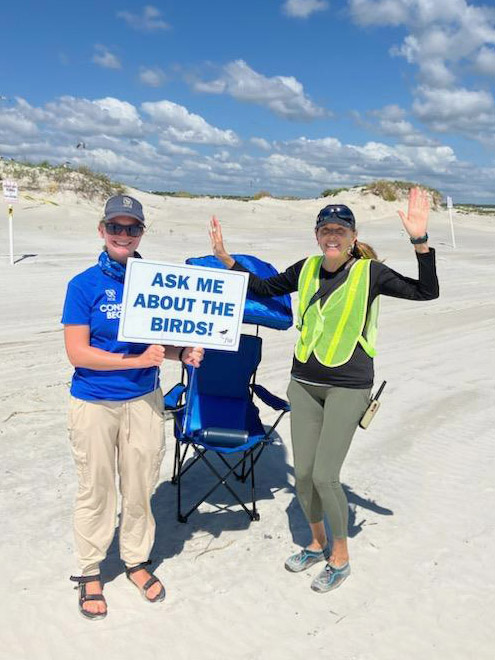 The Florida Shorebird Alliance (FSA) is a statewide network of local partnerships committed to advancing shorebird and seabird conservation in Florida. The Timucuan Shorebird Partnership (TSP) is our very own local program that works in collaboration with the FSA. TSP’s goal is to conserve shorebird and seabird populations right here in Clay, Duval, and Nassau counties through collaborative efforts between government agencies, non-government organizations, and individuals. The Timucuan Partnership includes the following partners: Audubon Florida, Florida Fish and Wildlife Conservation Commission, Florida State Parks, the City of Jacksonville, US Fish and Wildlife Service, Jacksonville Zoo and Gardens, National Park Service, North Florida Land Trust and SAISSA (South Amelia Shoreline Stabilization Association). The Florida Shorebird Alliance (FSA) is a statewide network of local partnerships committed to advancing shorebird and seabird conservation in Florida. The Timucuan Shorebird Partnership (TSP) is our very own local program that works in collaboration with the FSA. TSP’s goal is to conserve shorebird and seabird populations right here in Clay, Duval, and Nassau counties through collaborative efforts between government agencies, non-government organizations, and individuals. The Timucuan Partnership includes the following partners: Audubon Florida, Florida Fish and Wildlife Conservation Commission, Florida State Parks, the City of Jacksonville, US Fish and Wildlife Service, Jacksonville Zoo and Gardens, National Park Service, North Florida Land Trust and SAISSA (South Amelia Shoreline Stabilization Association).
We have an incredibly committed team of resource managers, interns and approximately 45 volunteers dedicated to research, management, education, public policy, and to protecting our Critical Wildlife Areas and focal species. 2023 was a great year for the partnership across all organizations with the entire team working together tirelessly in all types of weather.
Here are some key highlights and successes from the 2023 Timucuan Partnership:
 American Oystercatchers: 14 nesting attempts, or 6% of American Oystercatcher nesting attempts in the state. American Oystercatchers: 14 nesting attempts, or 6% of American Oystercatcher nesting attempts in the state.- Wilson’s Plovers: 84 nesting attempts, or 21% of Wilson’s Plovers nesting attempts in the state.
- Operation Wrack Line (FWC law enforcement initiative to reduce human disturbance throughout the state at priority shorebird, seabird, and wading bird sites): Huge increase in statewide patrols since 2018 (629) to more than 2,500 patrols recorded in 2023. Special thanks to all law enforcement personnel for their support this year!
- Big and Little Talbot Island State Parks: Overall, great Wilson’s Plover success for a total of 53 new nests.
- New Bird Island: Max count of 109 Black Skimmer nests, 41 Gull-billed Tern nests on the island. Even with two overwash events in August, the colony prevailed and fledged more than 20 Black Skimmer chicks and 2 Gull-billed Tern chicks.
- Huguenot Memorial Park: 3 American Oystercatchers were banded at the park. 20 Wilson’s Plover nests were recorded within the park with 8 confirmed chicks. There were 5 Least Tern colonies this year, and despite overwash and predation, at least 10 chicks fledged. Max fledge counts are: Royal Terns: 371, Laughing Gulls: 2,459, Sandwich Terns: 90. Brown Pelicans were still nesting in September; 25 feathered chicks were still in the dunes. Early predation management efforts will be implemented next season.
A pilot project this year at Huguenot was a sticker program for children. The stickers, which volunteers gave out during outreach walks, proved to be a great ice breaker and helped to open up meaningful conversations about shorebirds with both children and adults. The biggest surprise was the number of adults who wanted a sticker for their water bottle! 2024 will have another pilot, so stay tuned. Speaking of our volunteers, we recognize that our bird steward volunteers and interns are the core of the front line support for this incredible partnership. Hats off to our 2023 Bird Steward Team!
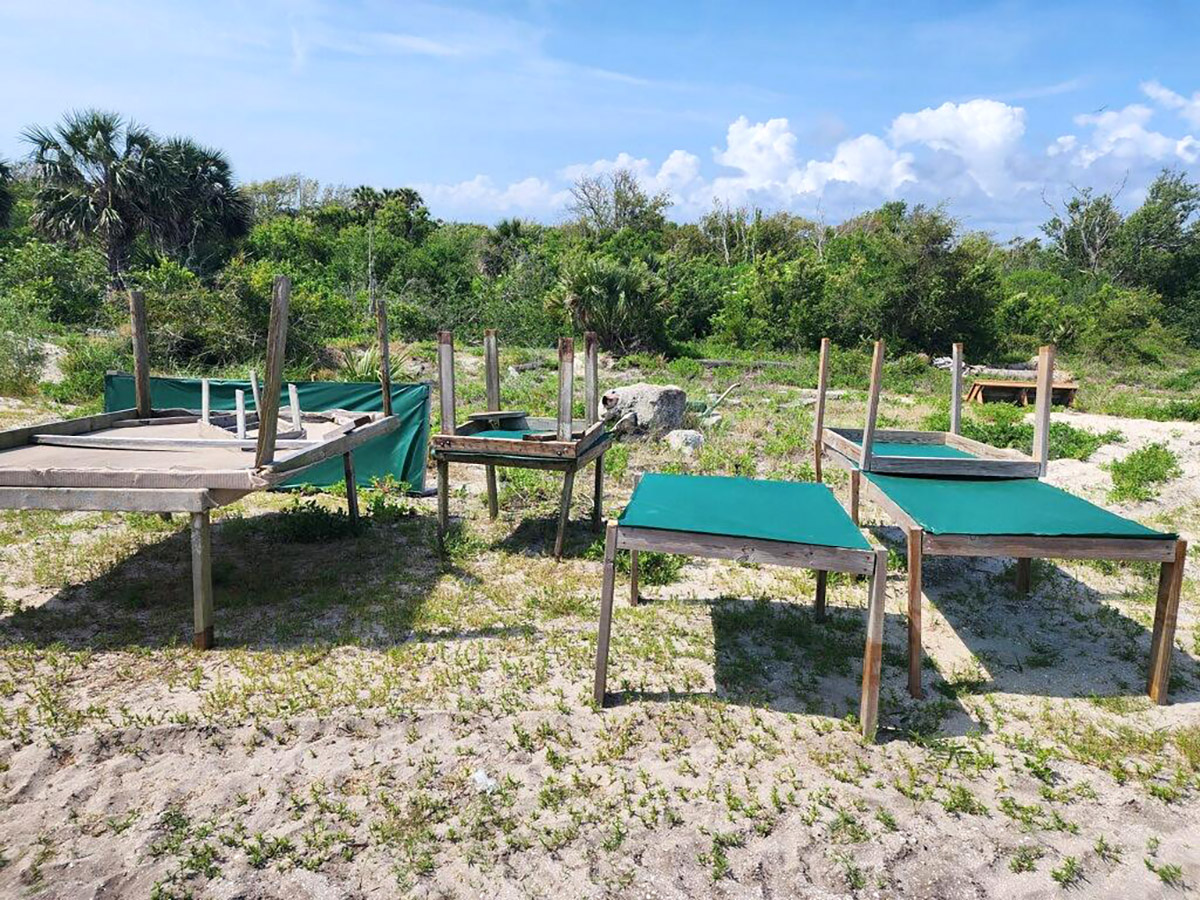 In mid-September, our End of Season Update and Volunteer Appreciation Luncheon was held at the beautiful Ribault Club. While the lunch was yummy, the best part was feeling super proud to have the opportunity to be part of such an impactful team that contributes every day to protect our vulnerable local species! Shout out to Audubon Florida’s Chris Farrell for providing our food and for this year’s new Shorebird Sun Shields! In mid-September, our End of Season Update and Volunteer Appreciation Luncheon was held at the beautiful Ribault Club. While the lunch was yummy, the best part was feeling super proud to have the opportunity to be part of such an impactful team that contributes every day to protect our vulnerable local species! Shout out to Audubon Florida’s Chris Farrell for providing our food and for this year’s new Shorebird Sun Shields!
In closing, while we all love the fall weather, our Shorebird Stewarding volunteers are looking forward to kicking off the 2024 spring season next May. However, the first spring event will be on February 19th, 2024: “Spring Shorebird Stewarding Program,” which will be presented by our very own City of Jacksonville Naturalist, Jolie Friedrich! You will not want to miss this engaging and informative presentation to learn more about why it is so important to protect our endangered shorebird species. The presentation will be held at the Heckscher Drive Community Center, and details for the program will be released in December. In the meantime, if you are interested in learning more about the many ways you too can contribute to protecting our local endangered species please click here. We do not require many hours of service, schedules are very flexible, and every time you finish your shift, you are guaranteed to know you protected the very vulnerable! Wishing everyone a wonderful holiday season and thank you for sharing the shore!
ADVENTURES IN BIRDING: SEEKING THE GRAY GULL
by Jessica Dyszel, Field Trips Director
In early September, Carol Bailey-White and I made a last-minute decision to try our luck with the Gray Gull, an extremely rare vagrant from the Pacific southern coast of South American that had turned up in the Panhandle of Florida. It would be the first official ABA record of this bird in the US, an opportunity we could not pass up.
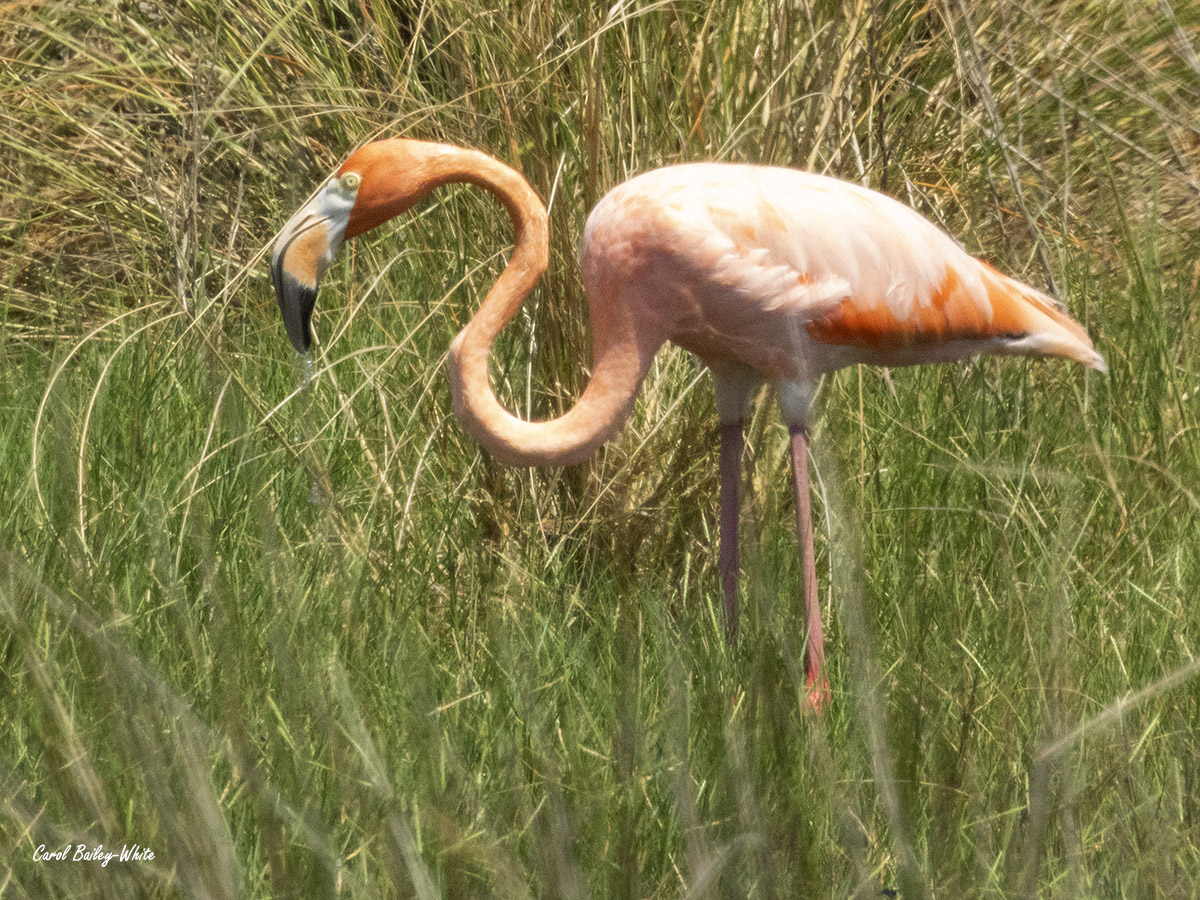 Heading west on I-10, we began our journey which brought us through the Tallahassee area where we surveyed some of the damage from Hurricane Idalia, known to all as the hurricane that brought the flamingos. Since were passing through the area, we decided to stop by St. Marks National Wildlife Refuge to see some of these blown-in hurricane flamingos and we were lucky to find one foraging in the grass by the lighthouse, giving us incredible views. Heading west on I-10, we began our journey which brought us through the Tallahassee area where we surveyed some of the damage from Hurricane Idalia, known to all as the hurricane that brought the flamingos. Since were passing through the area, we decided to stop by St. Marks National Wildlife Refuge to see some of these blown-in hurricane flamingos and we were lucky to find one foraging in the grass by the lighthouse, giving us incredible views.
Arriving in the evening in the Destin/Miramar area, Carol and I started our adventure going to some of the frequented areas of the gull. Alas, no luck. The next morning, we decided to try our hand at the beach access across from Stinky’s Fish Camp restaurant (which, in spite of the name, was not smelly at all, and had delicious food), where the gull had frequently been reported to be seen. We arrived only to see a group of happy birders leaving, stating that the bird had taken off but 30 minutes ago. Through my scope I could see the bird on the beach at Topsail Hill Preserve State Park several miles further to the west, so we decided to try our luck there. By the time we got there though, the bird had relocated. We spent the remainder of the day doing a stake-out waiting for the bird to return to us since chasing it had failed to that point. But unfortunately, no luck. The remainder of the evening, we tried chasing it with no success and connecting with other birders also chasing the gull, creating a communication chain that would alert one another if the gull was spotted. It was then we made the last minute decision to stay an extra unplanned night and try super early again at Stinky’s for the bird, hoping that our decision and strategy would pay off.
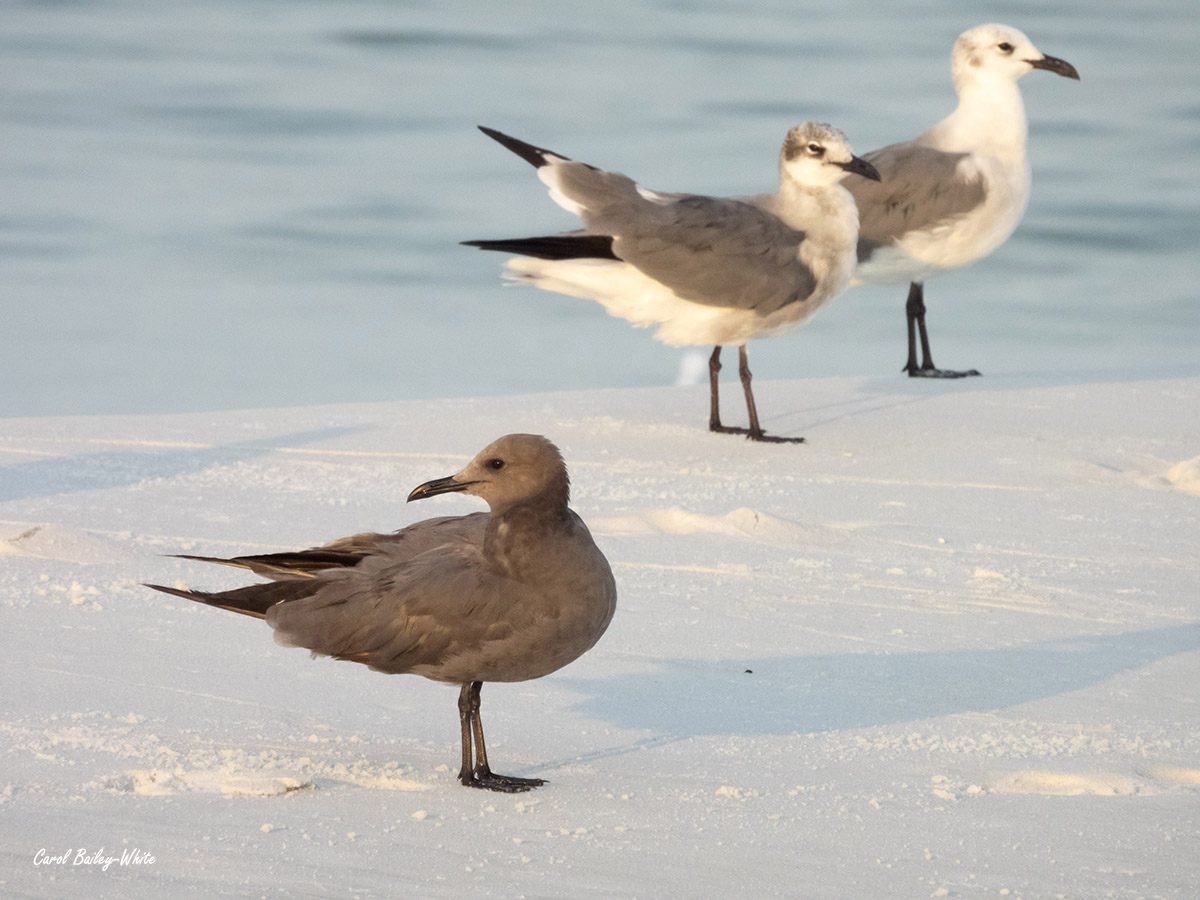 We slept nervously that night, fearing we had made an erroneous decision, risking another day for naught. We arrived at Stinky’s first thing in the morning and to our incredible relief, the gull was perched on the beach and we got amazing views. Not only did we get this incredible bird, but the friendships we made along the way made the trip well worth it. There is a sense of community when chasing rare birds that forms and it’s a unique bond that is shared between kindred spirits who search for something special. It’s a great feeling to know that you are not alone in the search and that other people are equally as passionate about finding the bird as you are. You also get to learn so much about the wonderful lives and work people are doing. It’s such a memorable experience and one with lasting memories, new friendships, and of course, a great life bird. We slept nervously that night, fearing we had made an erroneous decision, risking another day for naught. We arrived at Stinky’s first thing in the morning and to our incredible relief, the gull was perched on the beach and we got amazing views. Not only did we get this incredible bird, but the friendships we made along the way made the trip well worth it. There is a sense of community when chasing rare birds that forms and it’s a unique bond that is shared between kindred spirits who search for something special. It’s a great feeling to know that you are not alone in the search and that other people are equally as passionate about finding the bird as you are. You also get to learn so much about the wonderful lives and work people are doing. It’s such a memorable experience and one with lasting memories, new friendships, and of course, a great life bird.
GETTING TO KNOW OUR LOCAL OWLS
by Kate Zeray, Education/Youth Outreach Director
Every birder knows the pure delight of a surprise avian sighting, especially when it's one of your favorite genera of birds. On a recent hike at the GTM Research Reserve, a tall snag caught my eyes as the sun was quickly fading behind the trees--a pair of yellow eyes glowing right in my direction. My binoculars confirmed my instincts: a magnificent Great Horned Owl was perched atop the snag! I observed the raptor with a sense of awe as it surveyed the open field. This sighting was aptly timed as I have been reading the book What an Owl Knows by Jennifer Ackerman, and learning more about all of the unique characteristics and behaviors of owls.
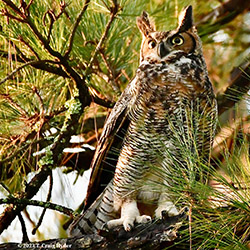 The Great Horned Owl is one of the largest owl species and has incredible features such as keen eyesight, ultra-sensitive hearing, and quiet flight. This species is found throughout North America and into South America, dwelling in nearly every habitat from the swamps of Florida to the canyons of the American West and northward into the forests of Canada. Unlike most birds, owls have forward-facing eyes like humans, which are essential to these fierce hunters' role within an ecosystem. Additionally, the Great Horned Owl has superb hearing and uniquely soft feathers that support its almost silent flight. The extraordinary skills of these raptors have earned them the nickname of "tiger owl." Interestingly, Corvids such as Crows, Ravens, and Jays, will often join together in behaviors such as chasing and dive-bombing to ward off a Great Horned Owl. The Great Horned Owl is one of the largest owl species and has incredible features such as keen eyesight, ultra-sensitive hearing, and quiet flight. This species is found throughout North America and into South America, dwelling in nearly every habitat from the swamps of Florida to the canyons of the American West and northward into the forests of Canada. Unlike most birds, owls have forward-facing eyes like humans, which are essential to these fierce hunters' role within an ecosystem. Additionally, the Great Horned Owl has superb hearing and uniquely soft feathers that support its almost silent flight. The extraordinary skills of these raptors have earned them the nickname of "tiger owl." Interestingly, Corvids such as Crows, Ravens, and Jays, will often join together in behaviors such as chasing and dive-bombing to ward off a Great Horned Owl.
 You are likely familiar with the hoots of an owl, but did you know that these sounds are often either territorial or mating behaviors among owls? According to Ackerman's research, the territorial hooting seems to be an alternative to fighting and thus minimizes the risk of injury to their vital eyesight. Learning the vocalizations of owls will certainly aid you in identifying their presence, as these nocturnal birds are more often heard than seen. In addition to the Great Horned Owl, other species that live in Northeast Florida are the Barred Owl and the Eastern Screech-Owl. A frequent flyer around the First Coast, the Barred Owl has a recognizable call which some people say sounds like, “Who cooks for you? Who cooks for you-all?” If you are anything like me, recalling this mnemonic phrase while hearing an Owl outside is quite a hoot! As you enjoy time outdoors this Fall, may you be delighted to encounter some of our local owls. You are likely familiar with the hoots of an owl, but did you know that these sounds are often either territorial or mating behaviors among owls? According to Ackerman's research, the territorial hooting seems to be an alternative to fighting and thus minimizes the risk of injury to their vital eyesight. Learning the vocalizations of owls will certainly aid you in identifying their presence, as these nocturnal birds are more often heard than seen. In addition to the Great Horned Owl, other species that live in Northeast Florida are the Barred Owl and the Eastern Screech-Owl. A frequent flyer around the First Coast, the Barred Owl has a recognizable call which some people say sounds like, “Who cooks for you? Who cooks for you-all?” If you are anything like me, recalling this mnemonic phrase while hearing an Owl outside is quite a hoot! As you enjoy time outdoors this Fall, may you be delighted to encounter some of our local owls.
VOLUNTEER SPOTLIGHT
by Jo El Snyder, Volunteer Director
Shout out to new volunteer Ethan Hoskins for his photography contribution to our Volunteer Hub. He wanted to get involved but doesn't have off weekends. I asked what he wanted to help with and he said photography---and I just so happened to be in NEED of avian pictures! He's been a dream.
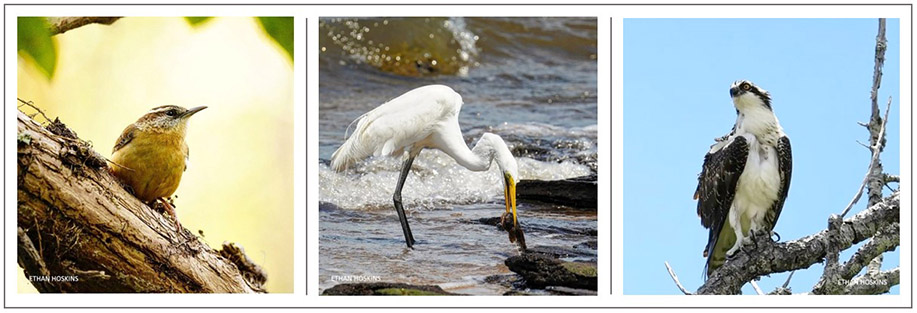
MEMBERSHIP AND CONSERVATION
by Christine Lucas, Membership Director
If you are an Audubon member, you've demonstrated your desire to protect birds and the habitat they need. Your membership is essential to our work. We're counting on you to continue supporting our on-the-ground conservation work. You can do that by renewing your membership today. To renew online, visit audubon.org/RenewNow. If you select an annual gift, your membership will automatically renew each year. This is an easy way to renew, and it puts an end to renewal reminder mailings. Thanks in advance for your ongoing commitment to the mission of Audubon.
Questions about your membership? Contact Membership Director Christine Lucas at christinelucas@duvalaudubon.org.
UPCOMING ACTIVITIES
Here's what's happening this month:
- Duval+Orange Audubon Co-op Birding by Bicycle or Car Lake Apopka Field Trip: 7:30 am - 5 pm, Saturday, November 4, 2023 (register here)
- Bird Walk for Beginners @ Fort Caroline National Memorial: 10 am - noon, Sunday, November 5, 2023 (register here)
 Monthly Program (in-person meeting): "Will Dickey shares his stunning nature photography of Northeast Florida" @ Southeast Regional Library, 10599 Deerwood Park Blvd, Jacksonville, FL 32256: 6:30-8 pm, Monday, November 13, 2023 Monthly Program (in-person meeting): "Will Dickey shares his stunning nature photography of Northeast Florida" @ Southeast Regional Library, 10599 Deerwood Park Blvd, Jacksonville, FL 32256: 6:30-8 pm, Monday, November 13, 2023- Nature Walk & Work Day @ Crosby Sanctuary: 8 am - noon, Saturday, November 18, 2023 (register here)
- Field Trip @ Sweetwater Wetlands Park ($5 per vehicle): 8 am - noon, Wednesday, November 22, 2023 (register here)
- Open House @ Crosby Sanctuary: 8 am - noon, Saturday, November 25, 2023 (no registration needed)
- The Best of Us: Photo Sharing and Pot Luck Luncheon @ The Peck Center (Fernandina Beach): 10 am - 12:30 pm, Saturday, December 2, 2023 (more info here)
Hope to see you soon!
Duval Audubon Society, Inc.
P.O. Box 16304
Jacksonville, FL 32245
www.duvalaudubon.org
    
|
|
|
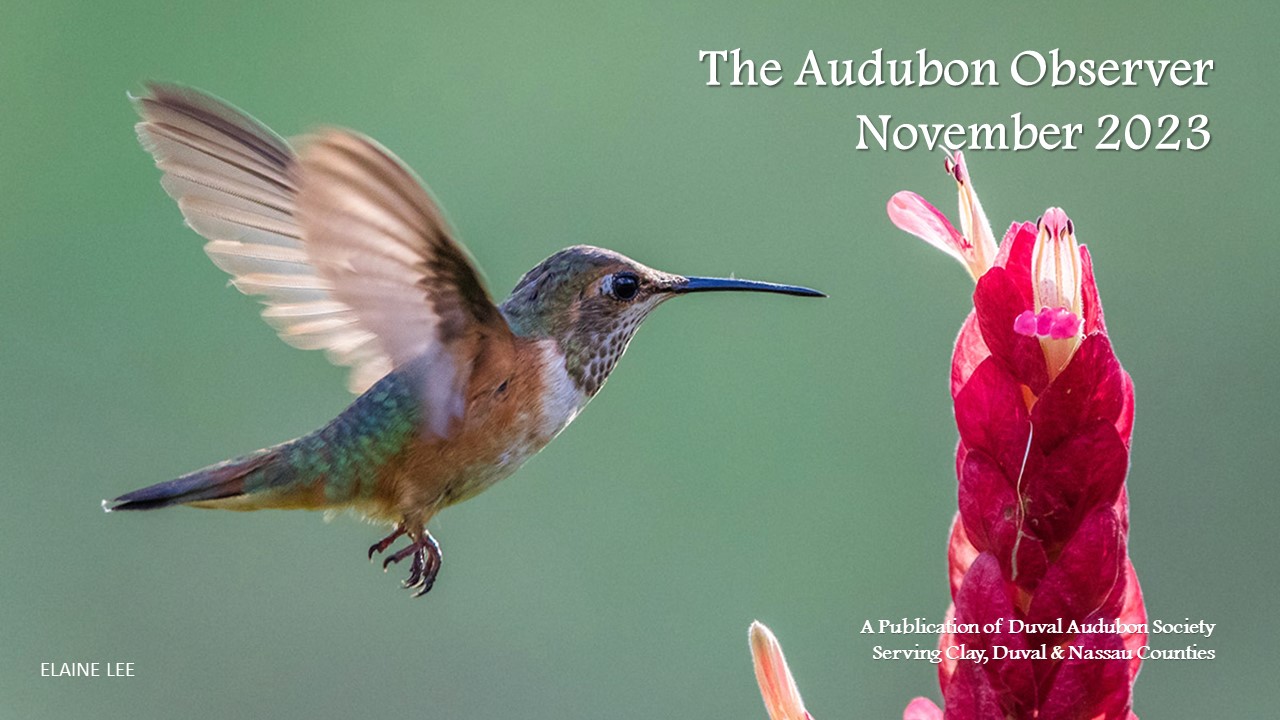
 The
The 
 In mid-September, our End of Season Update and Volunteer Appreciation Luncheon was held at the beautiful Ribault Club. While the lunch was yummy, the best part was feeling super proud to have the opportunity to be part of such an impactful team that contributes every day to protect our vulnerable local species! Shout out to
In mid-September, our End of Season Update and Volunteer Appreciation Luncheon was held at the beautiful Ribault Club. While the lunch was yummy, the best part was feeling super proud to have the opportunity to be part of such an impactful team that contributes every day to protect our vulnerable local species! Shout out to  Heading west on I-10, we began our journey which brought us through the Tallahassee area where we surveyed some of the damage from Hurricane Idalia, known to all as the hurricane that brought the
Heading west on I-10, we began our journey which brought us through the Tallahassee area where we surveyed some of the damage from Hurricane Idalia, known to all as the hurricane that brought the  We slept nervously that night, fearing we had made an erroneous decision, risking another day for naught. We arrived at Stinky’s first thing in the morning and to our incredible relief, the gull was perched on the beach and we got amazing views. Not only did we get this incredible bird, but the friendships we made along the way made the trip well worth it. There is a sense of community when chasing rare birds that forms and it’s a unique bond that is shared between kindred spirits who search for something special. It’s a great feeling to know that you are not alone in the search and that other people are equally as passionate about finding the bird as you are. You also get to learn so much about the wonderful lives and work people are doing. It’s such a memorable experience and one with lasting memories, new friendships, and of course, a great life bird.
We slept nervously that night, fearing we had made an erroneous decision, risking another day for naught. We arrived at Stinky’s first thing in the morning and to our incredible relief, the gull was perched on the beach and we got amazing views. Not only did we get this incredible bird, but the friendships we made along the way made the trip well worth it. There is a sense of community when chasing rare birds that forms and it’s a unique bond that is shared between kindred spirits who search for something special. It’s a great feeling to know that you are not alone in the search and that other people are equally as passionate about finding the bird as you are. You also get to learn so much about the wonderful lives and work people are doing. It’s such a memorable experience and one with lasting memories, new friendships, and of course, a great life bird. The Great Horned Owl is one of the largest owl species and has incredible features such as keen eyesight, ultra-sensitive hearing, and quiet flight. This species is found throughout North America and into South America, dwelling in nearly every habitat from the swamps of Florida to the canyons of the American West and northward into the forests of Canada. Unlike most birds, owls have forward-facing eyes like humans, which are essential to these fierce hunters' role within an ecosystem. Additionally, the Great Horned Owl has superb hearing and uniquely soft feathers that support its almost silent flight. The extraordinary skills of these raptors have earned them the nickname of "tiger owl." Interestingly, Corvids such as Crows, Ravens, and Jays, will often join together in behaviors such as chasing and dive-bombing to ward off a Great Horned Owl.
The Great Horned Owl is one of the largest owl species and has incredible features such as keen eyesight, ultra-sensitive hearing, and quiet flight. This species is found throughout North America and into South America, dwelling in nearly every habitat from the swamps of Florida to the canyons of the American West and northward into the forests of Canada. Unlike most birds, owls have forward-facing eyes like humans, which are essential to these fierce hunters' role within an ecosystem. Additionally, the Great Horned Owl has superb hearing and uniquely soft feathers that support its almost silent flight. The extraordinary skills of these raptors have earned them the nickname of "tiger owl." Interestingly, Corvids such as Crows, Ravens, and Jays, will often join together in behaviors such as chasing and dive-bombing to ward off a Great Horned Owl. You are likely familiar with the hoots of an owl, but did you know that these sounds are often either territorial or mating behaviors among owls? According to Ackerman's research, the territorial hooting seems to be an alternative to fighting and thus minimizes the risk of injury to their vital eyesight. Learning the vocalizations of owls will certainly aid you in identifying their presence, as these nocturnal birds are more often heard than seen. In addition to the Great Horned Owl, other species that live in Northeast Florida are the
You are likely familiar with the hoots of an owl, but did you know that these sounds are often either territorial or mating behaviors among owls? According to Ackerman's research, the territorial hooting seems to be an alternative to fighting and thus minimizes the risk of injury to their vital eyesight. Learning the vocalizations of owls will certainly aid you in identifying their presence, as these nocturnal birds are more often heard than seen. In addition to the Great Horned Owl, other species that live in Northeast Florida are the 
 Monthly Program (in-person meeting): "Will Dickey shares his stunning nature photography of Northeast Florida" @ Southeast Regional Library, 10599 Deerwood Park Blvd, Jacksonville, FL 32256
Monthly Program (in-person meeting): "Will Dickey shares his stunning nature photography of Northeast Florida" @ Southeast Regional Library, 10599 Deerwood Park Blvd, Jacksonville, FL 32256